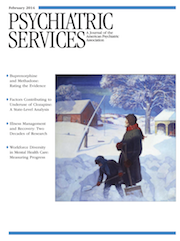Systematic Suicide Risk Assessment for Patients With Schizophrenia: A National Population-Based Study
Abstract
Objectives
Systematic suicide risk assessment is recommended for patients with schizophrenia; however, little is known about the implementation of suicide risk assessment in routine clinical practice. The study aimed to determine the use of systematic suicide risk assessment at discharge and predictors of suicide attempt among hospitalized patients with schizophrenia in Denmark.
Methods
A one-year follow-up study was conducted of 9,745 patients with schizophrenia who were discharged from psychiatric wards and registered in a national population-based schizophrenia registry between 2005 and 2009.
Results
The proportion of patients receiving suicide risk assessment at discharge from a psychiatric ward increased from 72% (95% confidence interval [CI]=71%−74%) in 2005, when the national monitoring began, to 89% (CI=89%−90%) in 2009. Within one year after discharge, 1% of all registered patients had died by suicide and 8% had attempted suicide. One out of three patients who died by suicide had no documented suicide risk assessment before discharge.
Conclusions
The use of systematic suicide risk assessment at discharge among patients with schizophrenia increased in Denmark between 2005 and 2009, in accordance with recommendations in national clinical guidelines and monitoring in a national clinical registry. Additional efforts are warranted to ensure a lower risk of suicidal behavior after hospital discharge.



